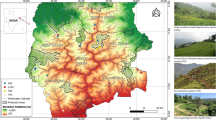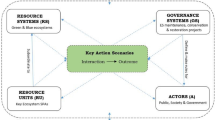Abstract
Ecosystem degradation caused by factors such as improper natural resources management and contamination with agricultural, industrial, and domestic wastes often results in the creation of an unhealthy ecosystem, a main cause for the prevailing poverty and poor health in many parts of rural Egypt. In collaboration with members of the community in some villages of El-Fayoum province, an interdisciplinary research team is currently employing an ecosystem approach to arrive at an understanding of community health problems with a view to develop resource management interventions and policies aimed at enhancing community health and well-being. Participatory rural appraisal (PRA) and knowledge, attitudes, and practices (KAP) techniques were used to measure the perceptions of the community’s men and women of their health and environmental priorities, and to test their current state of knowledge and awareness of the health-related issues. The results indicate that these perceptions were gender-sensitive and were different from those of Ministry of Health. Spatial and temporal monitoring and assessment of the ecosystem components revealed considerable land and water resources degradation. Presence of water pools and waterways in the vicinity of the residential areas enhanced the risk of water-associated diseases. Although, the disease-carrying vectors of schistosomiasis and malaria were detected in the waterways, the incidence of the two diseases was relatively low in the main village in contrast to the situation in the nearby hamlets. Prevalence of schistosomiasis was substantially higher in these hamlets (20–30% compared to 2–3% in the main village). Such a highly infected community represents a continuous pool of reinfection of the waterways, an issue that needs to be further examined to determine its relation to the hamlets’ specific ecosystem characteristics. A high incidence of hepatitis C and soil transmitted-intestinal parasites were markedly detected. It is concluded that in addition to natural resources degradation, other potential health risk factors were identified including socioeconomic, cultural, and institutional factors. Further studies are being conducted to explore these potential risk factors and their links to human health and well-being.




Similar content being viewed by others
References
Abd-Allah SM, Kishk FM (2002) Impacts of ecosystem degradation on farmer’s livelihood: a case study in the northern Nile delta, Egypt. In: Proceedings of the workshop “Alleviation of Poverty,” The Centre for Development Studies, Kerala, India, September 16–20, 2002
Abd-Allah SM, Kishk FM, Gaber HM (1999) Comparative efficacy studies using alternative pesticides (biopesticides, insect growth regulators [IGRs] and ivermectin) on anopheline-malaria mosquitoes in Egypt, WHO Report, TDR/EMRO
SM Abd-Allah HM Gaber FM Kishk (2004) ArticleTitleExploring children vulnerability to pesticide exposure health risks in El-Faiyoum, Egypt Alexandria Journal of Pharmaceutical Sciences 18 69–76 Occurrence Handle1:CAS:528:DC%2BD2cXkvVejtbY%3D
Abdel-Wahab, M (1993) Parasitological and Serological Studies on Malaria in Relation to Anopheline Distribution in El-Fayoum Governorate. MSc Thesis, Ain Shams University
MF Abdel-Wahab GT Strickland A El-Sahly N El-Kady S Zakaria L Ahmad (1979) ArticleTitleChanging pattern of Schistosomiasis in Egypt 1935–1979 Lancet 2 242–244 Occurrence Handle1:STN:280:CSaB2czjs1U%3D Occurrence Handle89343
MF Abdel-Wahab A Yosery S Narooz G Esmat S el Hak S Nasif GT Strickland (1993) ArticleTitleIs Schistosoma mansoni replacing Schistosoma haematobium in the Fayoum? American Journal of Tropical Medicine and Hygiene 49 697–700 Occurrence Handle1:STN:280:ByuC3cnntFQ%3D Occurrence Handle8279637
MF Abdel-Wahab G Esmat I Ramzy S Narooz E Medhat M Ibrahim Y Boraey GT Strickland (2000) ArticleTitleThe epidemiology of Schistosomiasis in Egypt: Fayoum Governorate American Journal of Tropical Medicine and Hygiene 62 IssueIDSuppl 55–64 Occurrence Handle1:STN:280:DC%2BD3c3ntFKjuw%3D%3D Occurrence Handle10813501
American Public Health Association (APHA) (1998) Standard Methods for the Examination of Water and Wastewater, 20th ed., Washington, DC: American Public Health Association
Bassiouny HK (1997) Determination of epidemiological factors causing persistence of Malaria: P. falciparum transmission in Faiyoum province, Egypt, WHO Report, TDR/EMRO
HK Bassiouny (2001) ArticleTitleBioenvironmental and meteorological factors related to the persistence of malaria in Fayoum Governorate: a retrospective study Eastern Mediterranean Health Journal 7 895–906 Occurrence Handle1:STN:280:DC%2BD2cvislCmuw%3D%3D Occurrence Handle15332730
R Chambers (1994) ArticleTitleParticipatory rural appraisal (PRA): analysis of experience World Development 22 253–1268 Occurrence Handle10.1016/0305-750X(94)90075-2
G Forget J Lebel (2001) ArticleTitleAn ecosystem approach to human health International Journal of Occupational and Environmental Health 7 S1–S37
Gaddal AA (1990) Agricultural development and health. In: Proceedings of the Conference on Development, the Environment and Health, Amman, Jordan, December 10–14, 1990, pp 71–74
PCC Garnham (1966) Malaria Parasities and Other Haemosporidia Blackwell Oxford
M Jimenez . la Paz Particlede AM la Horra Particlede L Pruzzo RM Palma (2002) ArticleTitleSoil quality: a new index based on microbiological and biochemical parameters Biology and Fertility of Soils 35 302–306 Occurrence Handle10.1007/s00374-002-0450-z
N Katz A Chaves J Pellegrino (1972) ArticleTitleA simple device for quantitative determination of Schistosoma mansoni eggs in faeces examined by the thick-smear technique Revista do Instituto de Medicina Tropical de São Paulo 14 394–400
Kishk FM, Abdallah SM, Gaber HM (2001) Development of Health Interventions for El-Faiyoum: A Holistic Agro-ecosystem Management Approach. Report submitted to IDRC, Canada
Kishk FM, Gaber HM, Abd-Allah SM (2003) Environmental health risks reduction in rural Egypt. In: Globalization, Health, and Environment, the Fourth Annual Global Development Conference, sponsored by Global Development Network, Cairo, Egypt, January 19–21, 2003. Available: http://www.gdnet.org/GDN_activities/annual_conferences/fourth_annual_conference/parallels4/parallels4.3.html
A Klute (1986) Methods of Soil Analysis Part 1, 2nd ed. Agronomy Monograph 9, ASA and SSSA Madison, WI
AL Page RB Miller DR Keeney (1982) Methods of Soil Analysis: Part 2. Chemical and Microbiological Properties, 2nd ed. SSSA Madison, WI
Peden D (2000) Ecosystem Approaches to Human Health: Is There a Doctor on the Farm? Program initiative, IDRC, Canada
P Peters A Mahmoud K Warren J Ouma T Siongok (1976) ArticleTitleField studies of a rapid accurate means of quantifying Schistosoma haematobium eggs in urine samples Bulletin of the WHO 54 159–162 Occurrence Handle1:STN:280:CSiC3snnt1Y%3D
P Peters M El-Alamy K Warren A Mahmoud (1980) ArticleTitleQuick kato-smear for field quantification of Schistosoma mansoni American Journal of Tropical Medicine and Hygiene 29 217–219 Occurrence Handle1:STN:280:Bi%2BC2s3pslU%3D Occurrence Handle7369441
Sowilem, M (1993) A Comparative Study on the Ecology and Biology of Malaria in El-Fayoum and Siwa Oasis, MSc Thesis, Ain Shams University, Cairo, Egypt
DL Sparks (1996) Methods of Soil Analysis: Part 3. Chemical Methods SSSA Book Series, Number 5, SSSA Madison, WI
A Tosson A Azza M Magdi A Abdel-Hamid M Mohammed M Iman (1995) ArticleTitleStudies on anopheline larvae in El-Fayoum Governorate, Egypt Journal of Egyptian Society of Parasitology 25 329–352
RW Weaver JS Angle PS Bottmoley (1994) Methods of Soil Analysis: Part 2, Microbiological and Biochemical Properties SSSA Book Series, Number 5, SSSA Madison, WI
WHO (1965) Snail Control in the Prevention of Bilharziasis. Geneva: WHO
WHO (1975) Manual on Practical Entomology in Malaria, WHO Division of Malaria and Other Parasitic Diseases. Part II: Methods and Techniques, Geneva: WHO
Acknowledgments
The authors acknowledge the financial and technical support provided by the International Development Research Centre (IDRC-Canada) and the Ford Foundation. The partnership we have established with the Kafr Fazara village community and NGO in this research endeavor is highly valued.
Author information
Authors and Affiliations
Rights and permissions
About this article
Cite this article
Kishk, F.M., Gaber, H.M. & Abd-Allah, S.M. Towards Enhancing Community Health in El-Fayoum, Egypt, Using Ecosystem Approaches. EcoHealth 1 (Suppl 2), SU84–SU96 (2004). https://doi.org/10.1007/s10393-004-0058-x
Published:
Issue Date:
DOI: https://doi.org/10.1007/s10393-004-0058-x




